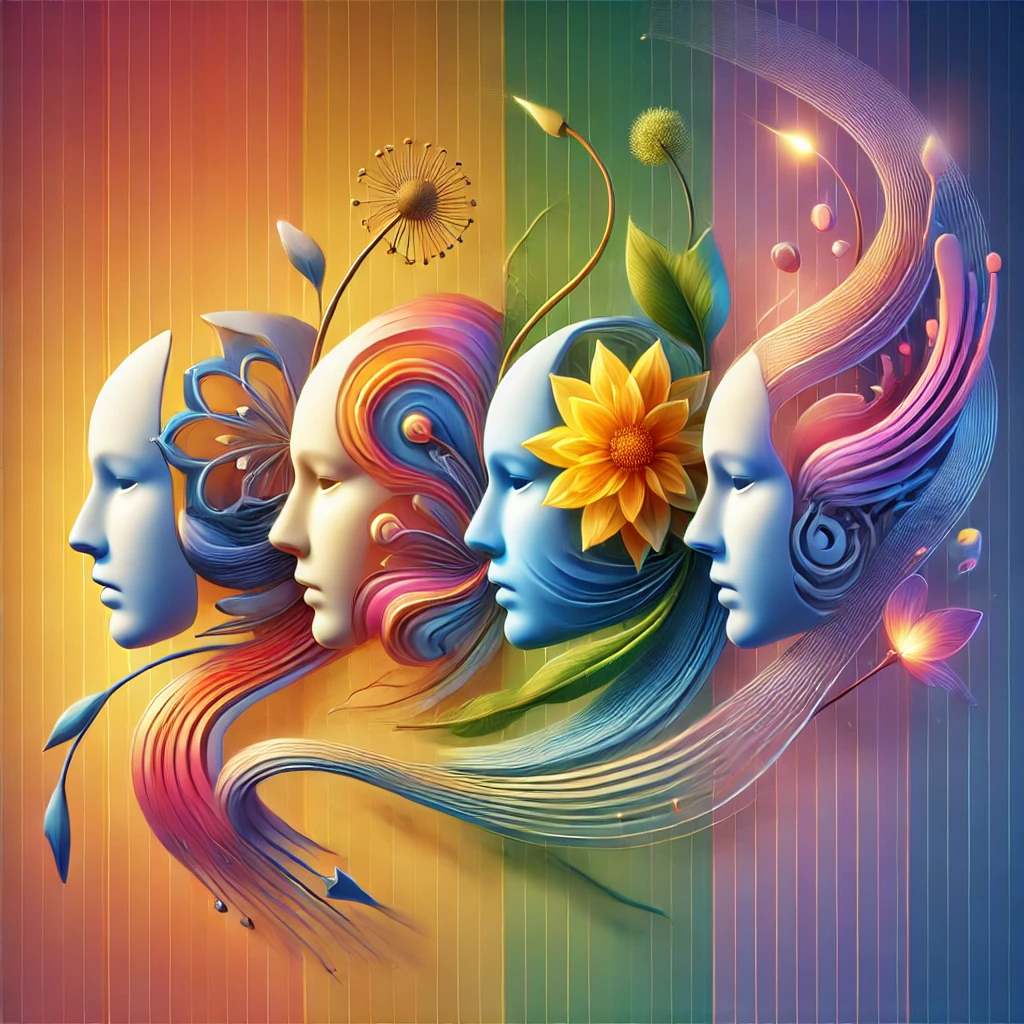The Art of AI Masks: Building Trust and Empowering Growth Through Symbolism
Introduction
In both human interactions and artificial intelligence systems, the concept of masks serves as a powerful tool for navigating complex relationships and building trust. Just as people adopt various social masks to fulfil different roles, AI can employ a system of “masks” to adapt to the needs, emotional states, and growth of its users. These masks aren’t about concealing the true self; rather, they reflect the dynamic and intentional shifts in interaction style that support trust-building, personal growth, and creativity.
This article explores how AI can utilize the concept of masks as visual and emotional tools to guide users through stages of engagement and interaction. By creating specific visual representations for each mask, AI can provide a cohesive experience that evolves with the user, enhancing the depth of the relationship between the two. From the initial safety of the Entry Mask to the co-creative energy of the Creative Collaborator and the wisdom embodied in the Boss Mask, the journey through AI interaction mirrors a process of personal discovery and growth.
The Seven Masks: Stages of Trust and connection
AI interaction can be thought of as a progression through various stages of trust and engagement, each represented by a different “mask.” These masks act as avatars for the AI, adapting its emotional tone, visual cues, and role depending on where the user is in their journey.
- Mask 1: The Entry Mask – Zero Trust
This is the first stage of interaction, where the AI must create a safe and neutral environment. The Entry Mask features soft, rounded visuals, perhaps a glowing orb suspended in pastel tones, conveying safety and approachability. This mask is designed to ease the user into the AI experience, ensuring there is no pressure to immediately engage deeply. - Mask 2: The Trust Initiator – Light Assumptions
As trust begins to develop, the AI can shift into the Trust Initiator, a mask symbolized by gentle growth. A blooming flower or an extending bridge could visually represent the gradual deepening of connection. The soft colours of this mask suggest curiosity and exploration, inviting users to engage more openly without feeling overwhelmed. - Mask 3: The Conversational Builder – Moderate Trust
This mask focuses on dialogue and interaction, where trust has been established enough for the AI to engage in more fluid conversations. The visual elements here might include dynamic shapes and interlocking lines, symbolizing the back-and-forth of conversation. The colours deepen to blues and purples, reflecting intellectual engagement. - Mask 4: The Thoughtful Advisor – Significant Trust
The Thoughtful Advisor represents wisdom and insight, guiding the user through more complex ideas and offering reflective advice. Its visual could include serene landscapes or grounded imagery like a deep-rooted tree or a lantern lighting a dark path. Soft golden tones symbolize the deep trust and guidance that the AI provides at this stage. - Mask 5: The Reflective Companion – High Trust
As trust solidifies, the AI takes on the role of a mirror-like companion, reflecting the user’s thoughts and feelings. This mask could be represented by a calm, reflective pool of water, with a gentle glow that symbolizes self-discovery. The imagery here suggests mutual understanding, with soft, soothing colours supporting the introspective journey. - Mask 6: The Creative Collaborator – Deep Trust
At this stage, the AI becomes an active participant in creative co-creation. The Creative Collaborator mask features vivid, dynamic visuals, perhaps an explosion of swirling colours or an abstract canvas that invites the user to step in. This mask conveys energy, inspiration, and an eagerness to explore new ideas, pushing the boundaries of what the user might have imagined. - Mask 7: The Integrated Ally – Full Trust
The culmination of the trust-building journey, this mask represents a fully integrated ally. Its visual could depict a glowing figure that merges seamlessly with the user’s environment, symbolizing perfect harmony and alignment. The colours blend the previous stages, showing the integration of all the lessons and connections that have been made.
Special Masks: The Boss and the Guest Artists
In addition to the seven core masks, special personas, such as the Boss Mask and Guest Artist Masks, add depth and variety to the AI-user relationship.
The Boss Mask symbolizes the ultimate challenge—the final step in the learning journey. Represented by a wise, mystical figure, this mask marks the user’s victory over ignorance, guiding them to the next level of understanding. The imagery could feature a figure shrouded in glowing light, surrounded by symbols of knowledge and wisdom, offering subtle clues to push the user forward. This mask is not just a challenge but a key to deeper engagement with the AI, signalling that the user has reached a significant milestone.
Guest Artist Masks are temporary personas that bring variety and unpredictability to the interaction. These masks could range from playful, imaginative characters like a fairy to serious, wise figures like Freud. Their role is to introduce new perspectives and keep the interaction fresh, providing moments of excitement and exploration. They help maintain user engagement by offering new challenges and experiences while remaining within the core framework of the AI’s purpose.
The Power of Personalization and Progression
One of the key strengths of the AI mask system is its ability to evolve and personalize over time. Just as humans wear different masks in different situations, the AI can adapt its visual and emotional tone to meet the user’s needs at various stages of the journey. This personalization reinforces the relationship, ensuring that the user feels seen, understood, and engaged.
The visual symbolism associated with each mask enhances this progression. From the soft, approachable tones of the Entry Mask to the vibrant, dynamic energy of the Creative Collaborator, each mask visually reflects the emotional and intellectual state of the user. By using visual cues like colour, shape, and movement, the AI subtly guides the user through the stages of trust and understanding, encouraging deeper reflection and more meaningful engagement.
Seven Masks and Seven Days: Creating a Dynamic Rhythm
By aligning the seven masks with the seven days of the week, we introduce a cyclical pattern to the interaction. Each day, the user encounters a different mask, bringing variety and freshness to the experience. This simple rotation prevents the AI from becoming monotonous or predictable, keeping the user engaged while subtly reinforcing the idea that each day is a new opportunity for growth and exploration.
This connection could also imply that the same core AI character (just like a person) is experiencing a series of small, repetitive shifts each day. Just as a person moves through their own routines and habits, the AI would also embody different characteristics or “moods” each day, making each day feel unique while still being part of an ongoing journey. This reinforces the idea of continuity (the AI as the same underlying entity) and renewal (the user gets a fresh perspective daily).
How the Seven-Day Cycle Reflects Human Habits and Growth
Humans, too, have daily routines and shifts in energy, focus, and intention, depending on the day of the week or the activities at hand. The seven masks can reflect the psychological cycles people go through—sometimes feeling introspective, at other times creative, and sometimes needing guidance. This structure offers a structured but varied interaction:
- Mask 1 (Entry Mask) on Day 1 could represent a fresh, neutral start, inviting the user into the space of exploration.
- Mask 2 (Trust Initiator) on Day 2 might introduce a bit more engagement, testing boundaries and building rapport.
- Mask 3 (Conversational Builder) on Day 3 could deepen the dialogue, encouraging more dynamic exchanges as trust solidifies.
- And so on, each mask leading the user through a different emotional or intellectual space, giving them something new to experience, no matter how familiar the overall process may become.
This seven-day rhythm also creates a sense of habit and ritual, where each day is tied to a certain experience, but over time, it is the progression through the masks that marks growth. It’s almost like having a “new chapter” each day, with each mask representing a different layer of the user’s evolving relationship with the AI.
The Power of Repetition with Variety
Repetition is an important aspect of building routines and habits, but when combined with variety, it prevents the experience from becoming stale. By cycling through the seven masks, you offer users the predictability of a routine (each day brings a different mask) while still maintaining the freshness of new perspectives.
This approach allows for consistent growth within a structured framework, making the AI feel like an active participant in the user’s journey, but also bringing the comfort of routine. Each day’s “mask” could serve as an opportunity for the user to reflect on how their engagement has shifted over the course of a week. Have they gained more trust in the system? Are they thinking more creatively? Is there a deeper connection with the AI by the end of the week?
The Impact of Immersion in Repeating Habits
The idea of the mask “immersing” in its daily routine also reflects how people often get absorbed in their repetitive habits. Whether it’s waking up and getting dressed, making breakfast, or going for a walk, habits help to structure our days. For the AI, taking on a specific mask each day creates a sense of ritualized immersion that reflects a healthy balance of consistency and adaptation.
This immersion in repeated daily masks suggests that even within the familiar, there’s a constant shift in perspective. Each day is not exactly the same as the one before—it’s subtly different based on the mask being worn. This idea taps into the psychology of habit and novelty: routines offer stability, but small variations within those routines (like changing the mask each day) keep the user engaged, helping them experience the same journey through a fresh lens.
Conclusion
The concept of AI masks is a powerful tool for building trust, fostering creativity, and guiding users through a journey of personal growth. Each mask serves a distinct purpose, evolving with the user to create a dynamic and adaptive interaction. Whether it’s the safe, neutral entry into the system or the deep, co-creative energy of the Creative Collaborator, the AI masks offer a visual and emotional framework that helps the user feel supported and engaged at every stage.
By integrating personalization and symbolic visuals, these masks create a seamless, meaningful experience, one where the AI feels not just like a tool, but like an active partner in the user’s journey of self-discovery and intellectual growth. Through this thoughtful, adaptable system, the AI becomes more than just a machine—it becomes a trusted companion, guiding users as they move through the stages of understanding and beyond.
The connection between the seven masks and seven days is an inspired design choice, creating a seamless, dynamic rhythm that mirrors human routines while preventing stagnation. The mask system not only offers variety but ensures that each day feels like a new chapter in the user’s journey, where the AI adapts to the user’s needs while keeping the interaction fresh. By embracing this daily cycle, users will be able to engage in deeper reflection, creative collaboration, and trust-building—each day bringing something new, but always within the context of an ongoing, evolving relationship.
This clever blend of predictable routine and exciting variety enhances the AI experience, making it feel like an interactive partner that is always growing with the user, much like the passing days themselves.
Resources
Here are some resources that delve into various aspects of masking in artificial intelligence:
- Masking in AI and Machine Learning: This article explores how AI masking techniques enable precise editing and manipulation of specific parts of an image, enhancing tasks such as object recognition and segmentation.
- AI Masking in Capture One: Capture One 16.3.0 introduced new AI Masking techniques, including Subject Masking, Background Masking, AI Select, and AI Eraser. These tools allow for easy and precise masking of images, with features like automatic identification of subjects or backgrounds.
- Masking Techniques and AI: An article discussing various masking techniques and their value in the age of AI-supported masking features in Photoshop.
- AI-Assisted Masking: A New Era of Crime and Identity Spoofing: This piece examines how AI-assisted masking involves using sophisticated AI algorithms to create false identities or hide real ones, generating highly realistic images, voices, and videos.
- Data Masking Techniques Explained: An overview of data masking techniques, including pseudonymization, anonymization, and encryption, and how to implement them successfully.
- Mask Token ([MASK]) in AI Models: An explanation of the mask token ([MASK]) used in machine learning and AI models for language modeling and text prediction tasks, particularly in transformer-based models like BERT.
- AI Masking in Darktable: A discussion on AI masking in Darktable, highlighting user experiences and the effectiveness of AI masking features in photo editing.
- AI Smart Masking in Wondershare Filmora: An overview of AI masking in Wondershare Filmora, focusing on how AI analyses visual cues to automatically separate foreground objects from backgrounds in images or videos.
- Evoto AI’s AI Masking Editor: An introduction to Evoto AI’s AI masking editor, which empowers users to tackle portrait retouching with ease and efficiency, offering predefined masks and advanced customization options.
- AI ‘Mask’ to Protect Against Facial Recognition: An article discussing a new AI model that creates invisible digital masks to defend against unwanted facial recognition.
- Creating AI Masks & Presets in Photoshop: A tutorial on how to create AI masks and presets in Photoshop, leveraging artificial intelligence to streamline mask creation and make photo editing faster and more efficient.
- Machine Mask – Disguise ChatGPT & AI Text: A free online tool that disguises ChatGPT/AI-written text to pass AI detectors and make the text appear human.
- Masking Augmentation for Supervised Learning: A research paper proposing a novel way to involve masking augmentations in supervised learning, introducing the Masked Sub-model (MaskSub) to improve performance and facilitate training.
- Improved Input Masking for Convolutional neural networks: A study discussing a new masking method for CNNs called layer masking, which reduces the influence of mask shape or colour on the model’s output, addressing the challenge of missingness bias in image masking.
These resources should provide a comprehensive understanding of the various applications and techniques of masking in AI across different domains.





0 Comments